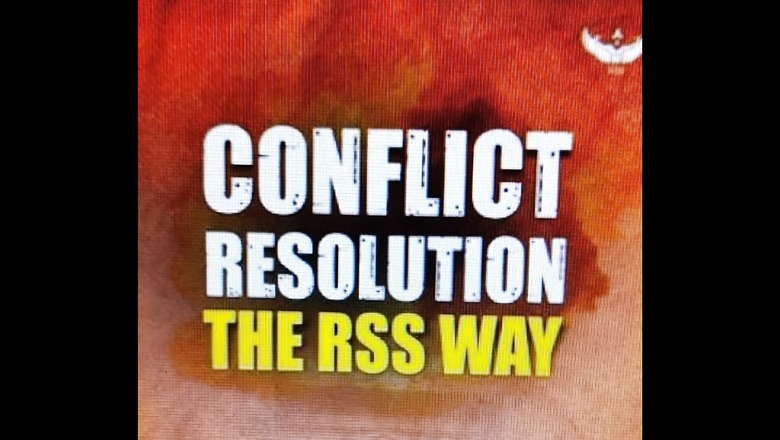
views
There is a sordid saga behind the rise of Jarnail Singh Bhindranwale. Punjab Kesari group head Lala Jagat Narain’s murder on November 9, 1981, was to put fear of God in common people’s hearts so no one dare speak against Bhindranwale. His strategy was to cause communal tension so that Hindus leave Punjab in fear and he hoped that a Hindu backlash in other parts of India would make Sikhs realise that they were safe only in Punjab.
It was a trying time for the nation. It showed how political expediency can almost destroy a nation. It was a testing time for RSS swayamsevaks who were seen as enemies of the Khalistani movement and were targeted. RSS fought against this separatist terror tooth and nail and had to sacrifice its people and also suffer organisationally.
RSS could clearly discern the seeds of separatism being sown during this time with mischief being played to divide the society that never was divided and never even thought in terms of separate Hindu and Sikh identities. Both respected each other’s identities and none ever felt threatened. The RSS resolution of 1982 underlined all these points.
RSS meeting of ABKM (Akhil Bharatiya Kendriya Karyakarini) was intensely anguished by the way the atmosphere of ill-will and hatred generated by some extremist elements during last few months in Punjab with the cry of Khalistan, plunging that strategic border area in internecine conflict. It noted incidents like throwing cigarette butt-ends and severed heads of cows into Gurudwaras and temples and said that this was done “with a view to desecrating them and inflaming passions as it can never be the handiwork of anyone with love for the integrity and unity of the country.”
RSS was the first to raise a finger of suspicion on foreign hands behind the divisive games and stated, “In view of the asylum extended by countries like Pakistan, England, America, Canada to extremist elements, existence of an international plot also cannot be ruled out. The indirect support to Khalistan extremists by certain political leaders for achieving their immediate political ends is most unfortunate.”
It condemned such pernicious attempts at engineering strife and conflicts in the Indian society. It reminded India again about pluralism of our tradition, “Various religious persuasions and faiths in the Hindu Society such as the Sikh, Sanaatani, Arya Samaji, Jain, etc. are diverse paths to reach the same goal, drawing as they do, inspiration from the same spiritual values and ideals.” Reminding the people of the history behind the birth of Khalsa Panth, resolution said, “When these ideals were faced with mortal danger, Guru Teg Bahadur recognised it as a threat to the Hindus and whole of Hindusthan and volunteered to offer his supreme sacrifice at its altar. And it was Guru Govind Singh who, with the clarion call of ‘May Hindu Dharma rise and the evil forces flee,’ roused nation’s martial spirit through the Khalsa. In response, countless heroes rose from the four corners of the land to plunge into the fire of martyrdom for the cause of Dharma. The inspiring saga of the Khalsa faith and its followers is therefore the proud heritage of the entire nation and not confined to any particular province. The Khalsa Gurus too had chosen the entire land as their field of action. No person with genuine faith in those Gurus would ever dream of chaining them within the bounds of a province, language or faith and thus slashing down their stature.”
Realising that it was the common person who can ultimately control this conflagration, it noted, “We express our satisfaction at the courageous restraint displayed by the common people of Punjab even in the face of grave provocation. We are confident that they will be vigilant enough to frustrate all such machinations of foreign stooges and self-seeking politicians who create internecine strife and weaken the country. We call upon our enlightened countrymen to denounce the mean and mischievous acts of extremist elements and keep aglow the inspiring tradition of our great forbears of standing foursquare against untruth and atrocity, under any guise or form.”
The resolution did not shy away from pointing its finger towards politicians and leaders of state and central governments for the deterioration of public peace and security.
This year saw the beginning of the bloodiest effort to vivisect India with Punjab as the launch pad. Pakistan, smarting under the failure of the 1965 Operation Gibraltar and the subsequent 1971 loss of entire East Pakistan, had declared its objective to ‘bleed India by a thousand cuts.’ Khalistani insurgency was part of this ambitious strategy. Sharing an easy to cross over border, Punjab seemed an easier prey. In the earlier days, Pakistan and UK were the main playgrounds of Khalistani leaders. Canada became a hub later. The entire episode blew up so suddenly, without any build up, that it seemed a clear case of conspiracy.
The heightened tension and violence is reflected in India Today report dated, April 30, 1983, “The change in political attitudes has come suddenly, and its consequence has been extremist and bloody. Less than two months after the last round of negotiations between Akali Dal leaders and Congress (I) broke down in New Delhi, Punjab is ablaze again. Violence on an unprecedented scale has gripped the state. Acts of terrorism, bomb blasts, murders and looting have become a daily routine. Over twenty agitators were killed in a single day during the successful ‘rasta roko’ campaign last fortnight. Ten days later a Home Guards armoury was looted in Ferozepur by terrorists. Rampant bomb explosions in Punjab’s towns—some eight blasts have been recorded since September 1981—have followed a pattern: the attempt has been to terrorise sections of the population, but not kill. In contrast to the recent spurt in deaths, only eighteen people died from blasts and in shoot-outs with the police since late 1981. The increased militancy of the protest in the last two weeks could prove to be, Akali leaders point out, only the beginning of a long and bitter battle. Already the Akali Dal is gearing itself for yet more serious confrontations in months to come.”
The report further adds, Dr Attar Singh, chairman of the School of Punjabi Studies in Chandigarh, formerly a close adviser of Giani Zail Singh, said: “The most dangerous development in Punjab today is the total tribal confrontation between the two communities. This has eroded rational thinking and promoted emotional responses.” “As long as Bhindranwale continues to have his way, Punjab will continue to burn,” says Virendra, editor of the popular Jalandhar daily Pratap.
According to this report, handling of this matter by PM Indira Gandhi was not thought through. Handing over the matter first to Foreign Minister PV Narasimha Rao, then former foreign minister Swaran Singh, then to unofficial mediators like J&K CM Farooq Abdullah, Congress (I) MP Amarinder Singh and Communist Party of India-Marxist MP Harkishen Singh Surjeet, was an attempt to pass the buck and buy time. It quotes the then BJP General Secretary LK Advani: “I must say that if the Akalis were adamant about certain issues, the government was yet more unreasonable on other issues.”
Khalistanis’ Antipathy for RSS
Why did RSS become anathema to Akali Dali? Koenraad Elst in his article Are Sikhs Hindus? notes, “RSS view that Sikhism was a branch of large Hindu Dharma umbrella and was inseparable part of Hindu society did not suit the politics of Akali Dal. Hence, SAD and SGPC have viewed RSS with suspicion. This resulted in long-standing animosity against RSS in Akali politics. Compulsions of religious and regional politics forced Akalis to find common grounds with Islam, which was a myth as all the battles by Sikh gurus and Khalsa armies were against Islamist oppressors and fought along with Hindus. While ‘banis’ of various Hindu saints occur in Guru Granthsahib, Muhammad is not mentioned even once in Nanak’s time; nor did any Guru praise Muhammad anytime. There are hundreds of places where the names of Ram and Krishna occur. Guru Gobind Singh was an ardent devotee of Durga. It speaks volumes about opportunistic Akali politics that SAD (Sikh Akali Dal) has had a very longstanding alliance with Jan Sangh and then with BJP to take advantage of consolidation of votes of Hindus with Sikhs to stay in power; but it treats RSS shabbily. SGPC has imposed an undeclared ban on entry of RSS or organisations allied to its philosophy.
“…Though (Guru) Govind Singh is considered as the founder of the Khalsa order (1699) who gave his Sikhs an outward form distinct from the Hindus, he too did things which Sikh separatists would dismiss as Brahminical. As Khushwant Singh notes, Gobind selected five of the most scholarly of his disciples and sent them to Benares to learn Sanskrit and the Hindu religious texts, to be better able to interpret the writings of the gurus, which were full of allusions to Hindu mythology and philosophy. Arun Shourie quotes Govind Singh as declaring: ‘Let the path of the pure (Khalsa panth) prevail all over the world, let the Hindu dharma dawn and all delusion disappear. May I spread dharma and prestige of the Veda in the world and erase from it the sin of cow-slaughter.’”
Panj piyaras (first five disciples) of Guru Gobind Singh came from different corners of Bharat and different castes. Similarly, the holiest of Gurudwaras are built in different regions of Bharat, not just in Punjab. RSS took a consistent stand to see that there is no divide between Sikhs and Hindus or ‘Keshdharis and Sahajdharis’ (those with uncut hair, beard-moustache and those without)—as Punjabis were called earlier. Guru Gobind Singh occupied a pride of place in the pantheon of great Hindu leaders of Bharat in RSS.
To counter the prevailing atmosphere, RSS swayamsevaks, with some other Hindu leaders, formed Rashtriya Suraksha Samiti (Punjab) in 1982 under the leadership of Omprakash Vaid to promote the idea of Hindu-Sikh brotherhood. The objective of the Samiti was to raise people’s morale, work hard to maintain harmony between Sikhs and Hindus, join the fight with terrorists at ideas level and give moral strength to the citizens of Punjab not to leave Punjab. But, after his death, the work slowed down. It was revived later in a big way in 1986 by Jaikrishan Sharma (ex-prachaarak) as its General Secretary with a small office on the premises of Durgiana Temple. In 1982, no one had a clue when and how it will all end. But, RSS was able to grasp the seriousness of this threat.
One cannot deny the world view of Guru Gobind Singh when discussing Sikh panth. Guru Gobind Singhji’s writings extol Bhagwan Shiv, Durga maa and various other gods in his Dasham Granth. Sanjeev Nayyar, independent columnist, researcher and founder www.esamskrit.com, notes, “The Siachen War Memorial has a plaque which quotes Guru Govind Singh ji and reads, ‘Oh Lord Shiva, grant me this boon that, never shall I shy away from doing good deeds. I should never be frightened away from fighting for justice, Dharma and rightful Cause and I should be determined to emerge victorious from this battle. May every soldier have a pure heart and mind and let not greed come near him. When the time comes for my soul to unite with yours, I should die fighting in the battlefield.”
Khushwant Singh wrote, “The roots of Sikhism lie deep in the Bhakti form of Hinduism. Guru Nanak picked what he felt were its salient features: belief in one God who is undefinable, unborn, immortal, omniscient, all-pervading and the epitome of Truth; belief in the institution of the Guru as the guide in matters spiritual; unity of mankind without distinction of caste; rejection of idol worship and meaningless ritual; sanctity of the sangat (congregation) which was expected to break bread together at the Guru ka Langar; the gentle way of sahaj to approach God while fulfilling domestic obligations; hymn singing (kirtan); emphasis on work as a moral obligation. The Adi (first) Granth is essentially a distillation of the Vedanta in Punjabi, the Dasam Granth is a compilation of tales of valour of Hindu goddesses, some composed by the Guru himself, others by bards of his court. […] Of the 15,028 names of God that appear in the Adi Granth, Hari occurs over 8,000 times, Ram 2,533 times, followed by Prabhu, Gopal Govind, Parabrahm and other Hindu nomenclature for the Divine. The purely Sikh coinage ‘Wahe Guru’ appears only sixteen times.”
This excerpt from Conflict Resolution: The RSS Way by Ratan Sharda and Yashwant Pathak has been published with the permission of Garuda Prakashan Private Limited.
Read all the Latest Opinions here


















Comments
0 comment